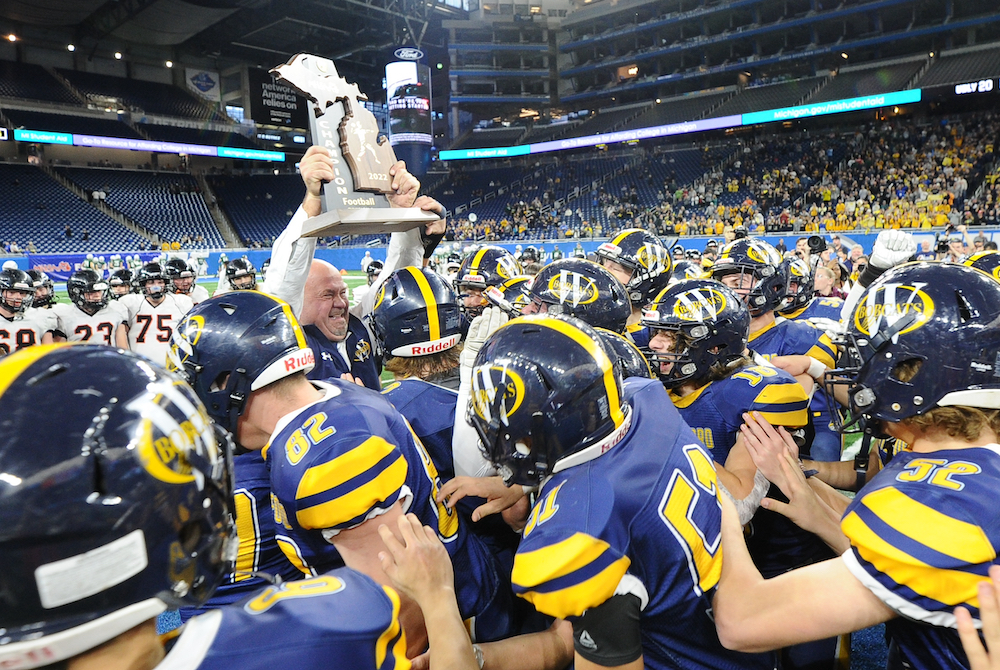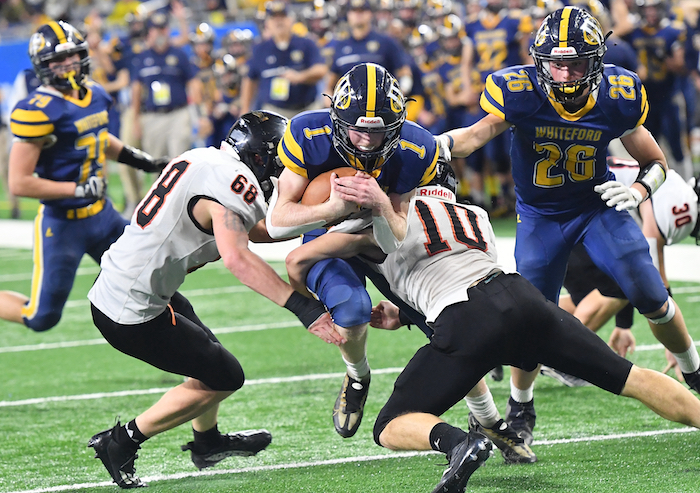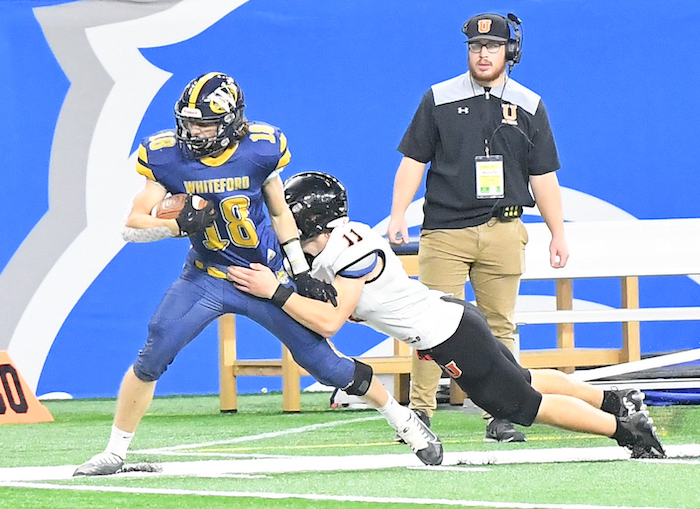
Inside Selection Sunday: Mapnalysis '13
October 28, 2013
By Geoff Kimmerly
Second Half editor
At the end of the day – Sunday, in this case – the 2013 MHSAA football playoff field was determined based on a set of numbers we began working with long before the first kickoff of this season.
So to kick off our discussion of how some of the 2013 playoff-selection decisions were made, here are a few numbers that might boggle the mind – or at least surprise:
- A total of 3,111 high school results were used in determining this season’s field – 2,978 for 11-player and 133 for 8-player games.
- We inputted and then followed the schedules for 623 MHSAA teams.
- We also inputted and followed weekly the schedules for 50 teams from surrounding states and Ontario that played at least one game against one of our MHSAA schools.
- We worked through complicated maneuverings made necessary by seven teams playing a mix of 11 and 8-player games, plus two more teams that played a mix of varsity and junior varsity opponents.
- And by Sunday morning we ended up with a few more numeric rarities: only 225 automatic qualifiers, the fewest since the current playoff system was introduced in 1999, and also an uneven number of at-large bids from our four classes because only six Class D teams reached the number of victories needed to be considered. (This was balanced by taking more at-large qualifiers from Classes A, B and C.)
And that was just the start of one of our most exciting days of the school year.
Following are more details. First, I explain some of the history of the MHSAA playoffs – I’ve lifted this in part from our 2012 report, so skip ahead if you’ve already got that down. Next, I touch on five themes that emerged as we built the brackets for this season’s tournament.
The process
Our past: The MHSAA playoff structure – with 256 teams in eight divisions, and six wins equaling an automatic berth (or five wins for teams playing eight or fewer games) – debuted in 1999, as mentioned above. An 8-player tournament was added in 2011, resulting in nine champions total when November is done.
That’s a long way from our start. The first playoffs were conducted in 1975 with four champions. Four more football classes were added in 1990 for a total of eight champions each fall. Through 1998, only 128 teams made the postseason, based on their playoff point averages within regions (four for each class) that were drawn before the beginning of the season. The drawing of Districts and Regions after the end of the regular season did not begin until the most recent playoff expansion.
In early years of the current process (or until the middle of the last decade), lines were drawn by hand. Dots representing qualifying schools were pasted on maps, one map for each division, and those maps were then covered by plastic sheets. Districts and Regionals literally were drawn with dry-erase markers.
Our present: After a late Saturday night tracking scores, we file in as the sun rises Sunday morning for a final round of gathering results we may still need (which can include making a few early a.m. calls to athletic directors). Then comes re-checking and triple-checking of enrollments, what schools played in co-ops, some records and more before the numbers are crunched and the fields are set.
Those 256 11-player teams are then split into eight equal divisions based on enrollment, and their locations are marked on digital maps that are projected on wall-size screens and then discussed by nearly half of the MHSAA staff plus a representative from the Michigan High School Football Coaches Association. Only the locations themselves are marked (by yellow dots) – not records, playoff point averages or names of the schools or towns. In fact, mentions of those are strictly prohibited. Records and playoff points are not part of the criteria. Matchups, rivalries, previous playoff pairings, etc. also DO NOT come into play. The same process is followed for organizing the 8-player bracket.
Observations and answers: 2013
This doesn’t happen overnight: Preparation for selecting the MHSAA playoff field begins long before the first kickoff of fall, much less the first practice. We load schedules for all 600-plus varsity teams during the summer, and many schedules remain fluid right up until the first Friday of the season – and this fall, a few weren’t settled until Week 2 or 3.
This summer as in some past we also worked through schools closing (Inkster, Saginaw Buena Vista, Detroit Northwestern, Flint Northern), and others deciding in mid-July and early August they would not field teams because of a lack of players.
Sometimes we have to take odd paths to find scores for these games. The last 11-player score to be added to our data this regular season came in as a result of tweeting the sports anchor of a Wheeling, W.Va., television station. Our last 8-player score came in via email from a Wisconsin athletic director at 10:30 Saturday night. Thankfully, we get plenty of assistance from some of our friends in the field, who keep an eye on the data and alert us when something appears missing or incorrect.
Win and advance: This season’s list of 5-4 teams includes a number of heavy hitters that did not receive at-large bids – East Grand Rapids, Utica Eisenhower, Orchard Lake St. Mary’s and Flint Powers Catholic to name a few. All were solid teams and played strong competition. All missing the playoffs likely raised some eyebrows.
But we have to take a look at this from a statewide view. There admittedly can be some argument about what schools qualified for the 226-256 spots in the field – but the important part is that 225 qualified because they all met the minimum win requirement. A playoff is simply that – it decides a champion based on teams winning. For some it’s harder to pile wins, of course, because they play in tough leagues. But the winners of those leagues are in the field – and surely will credit that tough road with getting them prepared to now play the state’s best.
Geography rules: This long has been rule number one for drawing MHSAA brackets in any sport, and is a repeat as well for those who have read this report the last two Octobers. Travel distance and ease DO come into play. Jumping on a major highway clearly is easier than driving across county-wide back roads, and that’s taken into consideration.
Also, remember there’s only one Mackinac Bridge and hence only one way to cross between peninsulas – and boats are not considered a possible form of transportation. When opponents from both peninsulas will be in the same District, distance to the bridge is far more important than as the crow flies.
The best example of this comes this season in Division 5. Grayling clearly is east of both Kingsley and Kalkaska – but also sits on I-75, while those two do not. So while those more western teams are geographically closer to Houghton, Menominee and Kingsford from the Upper Peninsula, we instead paired the three U.P. teams with Grayling because being on a main highway made for a shorter trip. The trip to Grayling for any of those U.P. teams would be 36 miles shorter to Grayling than Kingsley and 13 miles shorter to Grayling than Kalkaska.
Sometimes it’s where the points aren’t: Sure, it would be best-case scenario to have perfect sets of eight dots split into four quadrants from Calumet to Bedford. But generally that doesn’t occur. “Dots determine the map” is a common phrase heard here during this selection process, but that works the other way as well. If there are no qualifiers in a division from a specific area of the state – see Division 1, with none south of Holland or west of the greater Lansing area – there’s no choice but to create the unusual Regional Final possibility of Traverse City West vs. Brighton. Brighton is simply closer to the west side of the state than our other options.
Border to border vs. coast to coast: Should Regions be grouped north to south or east to west? There isn't a right or wrong answer – it just depends on that set of dots.
Whenever we have Upper Peninsula teams in a division, they’ll be grouped with those from the northernmost points of the Lower Peninsula for a District. The next northernmost schools will be grouped into a District, and together those eight will form a Region.
But the tough decision comes with the other six Districts. Look at this season’s Division 5 map: Six Districts are grouped south of U.S. 10 with three near or west of U.S. 127 and three east of that highway, which runs through the center of the Lower Peninsula. We grouped the two southwestern Districts into a Region and the two southeastern Districts into a Region – leaving a final Region that stretches from Muskegon on Lake Michigan to Almont, about 35 miles west of Lake Huron.
That’s a haul. But it’s also the best of our possible compromises. We could’ve instead paired regions that would’ve stretched from Hopkins to Monroe – only 19 fewer miles in distance than Muskegon Oakridge to Almont, but a scenario that could’ve created travel increases for a number of additional teams. Another option included a possible trip from Detroit University Prep to Freeland, which also would take more than two hours.
Bottom line – it’s been written here before – we pour all we have into this process, asking questions often more than once until we come up with a consensus. We do appreciate the arguments that arise once brackets are released to the public: The discussions are proof of how much players, coaches and fans care – and often show us new ways we can look at a system that’s now 15 years old.
But we must remember that the good news is the tournament is still set up to reward nine champions over the next five weeks, and five schools – Auburn Hills Oakland Christian, Coldwater, Detroit Allen, Eaton Rapids and Muskegon Mona Shores – will be competing for those titles for the first time.
It’s not so much how the tournament starts as how it ends. And we’re preparing for nine more memorable conclusions.
PHOTO: Each collection of grouped dots is a District on this season's Division 3 playoff map.

Ruddy Makes Biggest Plays at Most Crucial Times as Whiteford Wins 2nd Title
By
Paul Costanzo
Special for MHSAA.com
November 25, 2022
DETROIT – When the Ottawa Lake Whiteford offense took the field Friday with the Division 8 championship on the line, head coach Todd Thieken had a message for his offensive coordinator:
Put the ball in Shea Ruddy’s hands.
Need to convert a crucial fourth down near midfield?
Put it in Ruddy’s hands.
Facing a 3rd-and-goal from the 7?
Let Ruddy make the decision to run or pass.
The senior quarterback paid off his coach’s confidence, making the plays the Bobcats needed and leading a go-ahead touchdown drive in Whiteford’s 26-20 victory against Ubly at Ford Field.
“I want us doing things that he’s either running it, or he’s directing the play in some way, shape or form,” Thieken said. “Obviously there were some big plays – (Hunter DeBarr and Jake Iott) made some big runs on that drive, (Ruddy) did, as well, big catch out of (Kolby Masserant). When I’ve got guys like this, I’m not going to sit here and lie and say I wasn’t nervous because the game’s on the line. But I definitely had a quiet confidence about what we had in front of us.”
Ruddy finished the game with 177 yards of total offense and two touchdowns to lead Whiteford to its second Division 8 title, the previous coming in 2017.
 His second rushing touchdown of the day came with 1 minute, 59 seconds to play, breaking a 20-all tie.
His second rushing touchdown of the day came with 1 minute, 59 seconds to play, breaking a 20-all tie.
“Originally I was just going to throw it,” Ruddy said. “But there was a lot of room to run so I just tucked it and figured I could get there.”
The touchdown run capped an 80-yard drive that took 7:42 off the clock. It included a 4th-and-5 conversion near midfield in which Ruddy rushed for seven yards. Nine of the 17 plays on the drive were either a pass or Ruddy run.
“That kid’s a heck of a player,” Ubly coach Eric Sweeney said. “That’s the best athlete I’ve seen this year. He’s quick, explosive and when you get a kid like that in space, he’s tough to tackle.”
It appeared that Ruddy had made it 28-20 with a two-point conversion, but a replay review showed he stepped out of bounds just prior to hitting the pylon. That gave Ubly (13-1) some renewed hope going into its final drive, but the Bearcats couldn’t move the ball. A fourth down throw, hurried by immediate Whiteford pressure off the edge, was knocked away by Ruddy’s younger brother, Ryin, and Whiteford (14-0) was able to run out the clock in the victory formation.
“That was probably one of the best high school football games I’ve ever been a part of,” Thieken said. “I’ve been coaching football for over 30 years, and the way that both teams out there just battled right down to the wire, the way the teams were going at it. … The way we finished that game was a testament to all 51 kids on our football roster and the way they worked since last June.”
Whiteford’s go-ahead drive came after Ubly had erased a two-touchdown deficit and captured the game’s momentum.
The Bearcats – who were making their third Finals appearance and first since 2020 – went down 12-0 in the first quarter, and trailed 20-6 in the third before turning things around.
They did it by not straying from the gameplan they’ve had all season – running the ball straight at their opponent.
 Seth Maurer scored both second-half touchdowns, one on a 31-yard run, and the other on a 9-yard run. Ubly rushed for 107 yards on 12 carries during the third quarter alone.
Seth Maurer scored both second-half touchdowns, one on a 31-yard run, and the other on a 9-yard run. Ubly rushed for 107 yards on 12 carries during the third quarter alone.
“The resiliency of these kids? They’re tough,” Sweeney said. “Cornfield tough is what I would say. They never quit, which I wouldn’t expect these kids to quit. They really battled. I couldn’t be prouder. We have to come down here and win one of these, but the kids played hard and left it all out on the field. I couldn’t be prouder of them.”
Whiteford jumped out to its 12-0 lead thanks in part to an Ubly fumble on its opening possession. The Bobcats capitalized with a 26-yard TD run by DeBarr.
After a defensive stop, the Bobcats went 80 yards on 14 plays, scoring on a 1-yard run by Shea Ruddy.
Ubly would make it 12-6 with a 2-yard touchdown run by Mark Heilig. The drive was set up by an Evan Peruski interception at the Whiteford 30-yard line.
Whiteford stretched the lead to 20-6 right after the half, as it went 80 yards on 12 plays, scoring on a 4-yard run from DeBarr. Ruddy ran in the two-point try.
DeBarr finished with 94 yards rushing and the two touchdowns for Whiteford, while Ruddy had 65 yards on the ground and 112 yards on 8-of-12 passing. He also had an interception and tied his brother for the team lead with 12 tackles.
Masserant had five catches for 82 yards, and Iott had 11 tackles.
Maurer finished with 129 yards rushing for Ubly, while Heilig had 82.
Canden Peruski led the Ubly defense with 14 tackles, while Aiden Mackowiak had 13.
PHOTOS (Top) Whiteford coach Todd Thieken presents the Division 8 championship trophy to his team Saturday at Ford Field. (Middle) The Bobcats’ Shea Ruddy (1) pushes forward with Ubly’s Parker Peruski (68) and Evan Peruski (10) working to take him down. (Below) Ubly’s Luke Volmering (11) wraps up Whiteford’s Kolby Masserant. (Click for more from Hockey Weekly Action Photos.)

